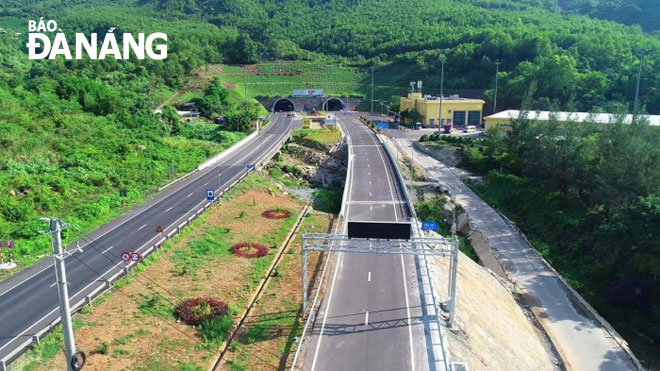A new vision set for Da Nang transport system
Da Nang has taken actions in a bid to accelerate transport infrastructure projects over recent years, hereby bringing up an impressive urban facelift to the city and considerably making it stand stronger on its feet during the journey of industrialisation and modernisation.
 |
| Many important traffic works have been put into use, considerably driving the city’s growth. Here is a view of the Hue T-junction overpass. |
Promoting investment in transport infrastructure
Public transport networks within Da Nang have developed strongly in both quality and quantity, meeting the growing travel demand of locals and tourists.
Before 1997 when Da Nang was separated from the former Quang Nam - Da Nang province to become a centrally-governed city, its urban technical infrastructure had been still very modest with only two bridges connecting the eastern and western banks of the iconic Han River, namely Nguyen Van Troi and Tran Thi Ly bridges.
As of late December, 2019, the city had housed 2,440 streets with a combined total length of 1,436.63 km, an increase of 265.59 km compared to early 2015, along with 74 bridges totalling 14,961.50 m and 7 inland waterway routes stretching a sum of 63.2km.
Over 2015 - 2020 period, the volume of transported freight and passengers climbed by 8.3% and 6.3% year-on-year, respectively. The total revenue generated from all transport services recorded an annual hike of 6.6%. Likewise, the total amount of cargo through local ports stood at 43.1 million tonnes, up 9.3% on a yearly basis.
Such important traffic works as Hue T-junction overpass, Da Nang - Quang Ngai Expressway, the La Son - Tuy Loan section of Ho Chi Minh Highway, the Hoa Phuoc - Hoa Khuong southern belt road and extended Nguyen Tat Thanh Street have been put into use, considerably driving the city’s growth.
These figures show the fact that Da Nang itself made a great leap in terms of transport infrastructure.
 |
| The approach road to the Hai Van 2 tunnel has just been put into use, contributing to improving traffic connection in Central Viet Nam. |
Big projects ahead
Under the Prime Minister’s recent approval for adjustments to the master plan for Da Nang’s major developments to 2030, with a vision to 2045, the Da Nang Internaitonal Airport eyes to have an annual capacity of handling 30 million passengers and 200,000 tonnes of cargo.
Meanwhile, once completed, the Lien Chieu port will boast annual capacity of handling 50 million tonnes, covering an area of about 450ha (including the water surface).
Under the long-term plans, Tien Sa Port, built by the Americans in 1965, which has been overloaded with cruise and cargo ships, will be used as a major port for cruises only, while Lien Chieu Port will handle cargo ships, and become a main logistics centre for the north-south railway and road systems and the East-West Economic Corridor (EWEC).
The existing Tho Quang wharf will be upgraded to serve as the major port for ships of between 10,000 and 20,000 tonnes, with a specialised pier for ships of between 5,000 and 10,000 tonnes.
In regard to the railway infrastructure, the new railway station with an annual capacity of 10 million passengers and a cargo terminal in the Kim Lien area for its connection with Lien Chieu Port will be developed in the years ahead.
As for waterways, the Master Plan orientates the development of inland waterway routes such as Han River - Co Co River - Thu Bon River, Han River - Vinh Dien River - Thu Bon River, Da Nang Bay - Hon Son Tra Con, and Da Nang-Cu Lao Cham or the Cham Islands off Quang Nam Province.
Work is expected to start on the development of 8,228 billion VND tunnel through Da Nang International Airport, a massive public transportation system featuring metros and tramways totalling 54,500 billion VND, a metro line connecting Da Nang and Hoi An valued at 7,497 - 14,995 billion VND.
Likewise, the city centre will see upgrade on major routes, such as Le Duan route connecting with Dong Da route creating a connecting axis from Dien Bien Phu to 3 February streets; Hoang Hoa Tham route running through Nguyen Tat Thanh route (running through the existing railway station) to create the main connecting axis from Nguyen Huu Tho - Le Dinh Ly - Hoang Hoa Tham - Nguyen Tat Thanh in order to reduce volume of traffic passing through adjacent roads.
By THANH LAN – Translated by A.T